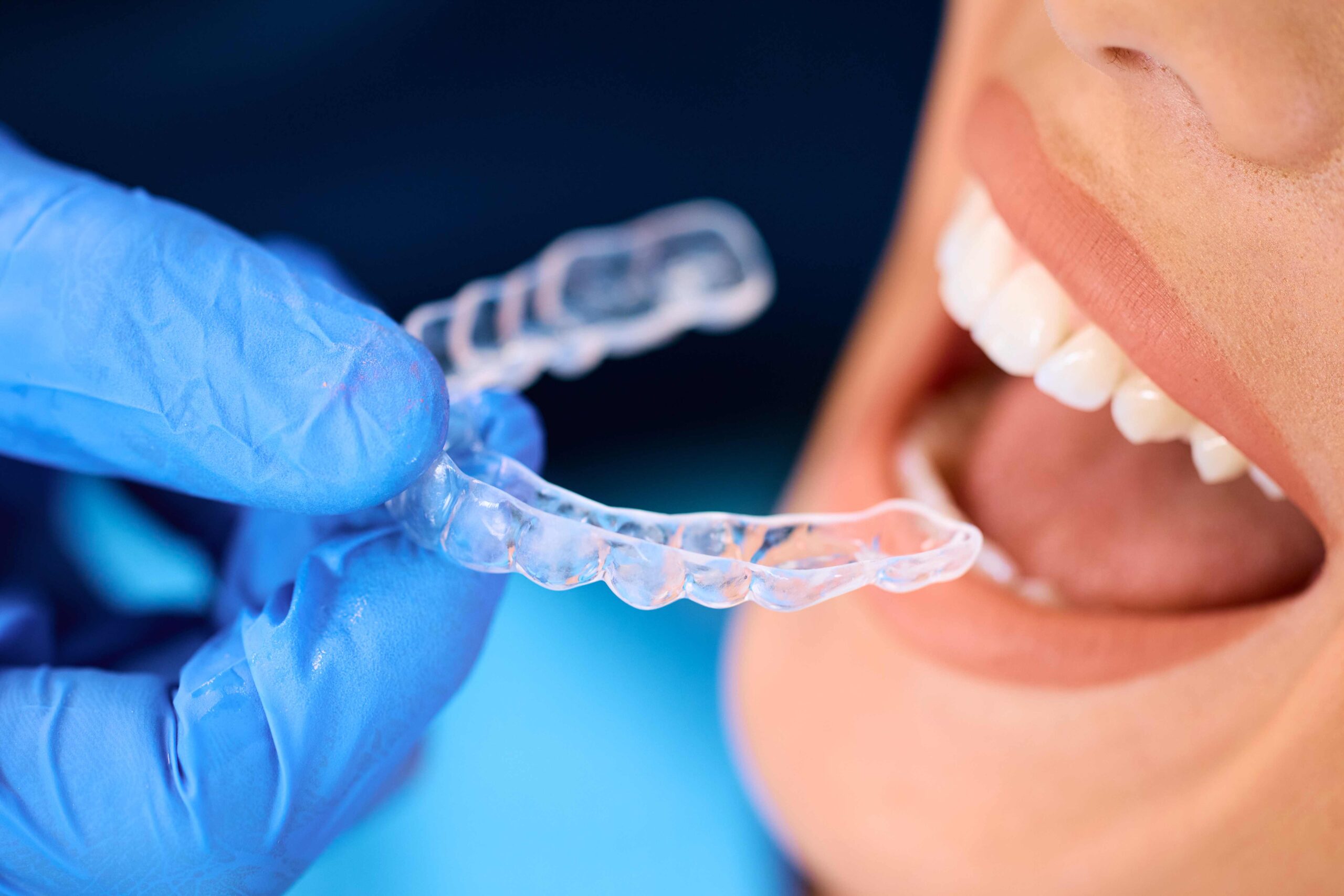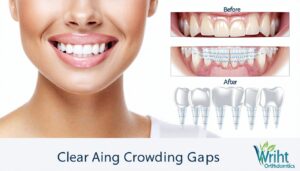Understanding Clear Aligners
For those in pursuit of a beautiful smile, clear aligners for teeth offer an effective and discreet solution. This section delves into what clear aligners are and how they work.
What are Clear Aligners?
Clear aligners, as the name suggests, are nearly invisible plastic shells designed to fit over your teeth. They are plastic replicas of teeth that apply gentle pressure to reposition teeth, making orthodontic treatment less conspicuous and providing an option to achieve a straight smile almost invisibly (AAO).
These aligners are designed to minimize the appearance of the appliance and fit well into any lifestyle; they are clear, thin, plastic-like trays that are virtually invisible. Tooth colored attachments are often placed on the teeth to help guide them into position.
How Clear Aligners Work
Much like dental braces, clear aligners work by creating mild pressure on teeth, slowly pushing the teeth into the desired position over time. Each aligner is typically worn for 1 week at a time, at least 22 hours a day, and moves teeth a fraction of a millimeter at a time.
Clear aligners must be replaced at regular intervals, generally every two to three weeks, to further reposition the teeth as necessary until the desired results are achieved by the dentist. The specific timeline for aligner replacement and the overall treatment duration largely depend on the individual’s orthodontic needs.
In summary, clear aligners offer a modern, discreet, and effective approach to orthodontic treatment. They represent a viable alternative to traditional braces, especially for those who value aesthetics and convenience. However, like all orthodontic treatments, the success of clear aligners depends on the individual’s commitment to following the prescribed treatment plan and maintaining good oral hygiene.
Effectiveness of Clear Aligners
With the advancements in dental technology, clear aligners for teeth have become a popular choice for individuals seeking to improve their smile. Let’s delve into the conditions that these devices can treat and their suitability for different individuals.
Conditions Treated by Aligners
Clear aligners are nearly invisible plastic shells that apply gentle pressure on the teeth to gradually reposition them. According to the American Association of Orthodontists (AAO), each aligner is typically worn for 1 week at a time, for at least 22 hours a day, and moves teeth a fraction of a millimeter at a time.
These aligners can treat conditions such as crowded or crooked teeth, providing a less visible alternative to traditional braces for individuals seeking straighter teeth. The treatment process works in three phases: First, space is created for tooth movement. Next, the repositioning of teeth begins. Finally, teeth are stabilized in their new positions. Each phase builds upon the progress made in the previous one, gradually moving the teeth closer to their final position.
Suitability of Clear Aligners
Clear aligners are most effective for straightening teeth with mild to moderate problems. Severe cases may require more complex treatment that is treated best with traditional braces, sometimes in combination with aligners (AAO).
Companies like Invisalign claim their aligners are faster, more comfortable, and reshape smiles more predictably compared to braces. They are designed using insights from millions of smiles and can produce results in as little as 6 months, with changes visible in just a few weeks (Invisalign).
Clear aligners like those offered by Invisalign and Straight Teeth Direct are recommended for all age groups, including children (6 years and older), teens, and adults. They offer a discreet alternative to traditional braces with predictable results and are less noticeable compared to traditional braces, which use archwires and brackets (Invisalign).
In addition, Straight Teeth Direct uses a two-step A and B aligner system to ensure comfortable treatment. Soft aligners are used initially to ease into the process, ensuring safe movement for both the patient and their teeth, while the more rigid B aligners stabilize teeth and surrounding tissues before progressing to the next stage.
However, it’s important to note that the effectiveness of clear aligners can vary based on individual factors and the complexity of the case. Therefore, it’s recommended to consult with an orthodontist to determine if clear aligners are the right treatment option.
Choosing Between Braces and Aligners
Selecting between braces and clear aligners is a significant decision that should be made with the guidance of an orthodontist. It’s important to consider multiple factors, including the complexity of your orthodontic case, to determine the most effective treatment option for you.
Consultation with Orthodontist
To determine the best treatment between braces and clear aligners for teeth, it’s crucial to consult with an orthodontist. These professionals are most qualified to assess your orthodontic needs and recommend the most suitable treatment.
A thorough examination will be conducted during the consultation, which may involve X-rays and dental impressions. This will help the orthodontist understand the complexity of your case and design a treatment plan that best suits your needs.
Complex Orthodontic Cases
Clear aligners are effective for straightening teeth with mild to moderate problems. However, severe cases may require more complex treatment that traditional braces can best address, sometimes in combination with aligners (AAO).
In cases where an individual’s teeth do not fit ideally within the aligners, minor reshaping or resizing procedures can be implemented. These adjustments are minimally invasive and typically do not require anesthesia due to their non-discomforting nature. However, clear aligners may not be suitable for severe cases requiring complex tooth movements, which might be better addressed with traditional orthodontic treatments to achieve the desired outcome effectively.
Clear aligners are a suitable orthodontic treatment option for a broad range of cases, from minor to complex conditions. The number of aligners, treatment duration, and success rate depend on the individual’s specific bite complexity, consistency in wearing the aligners, and the level of resistance to tooth movements exhibited by their jawbone.
Clear aligners must be replaced at regular intervals, generally every two to three weeks, to further reposition the teeth as necessary until the desired results are achieved by the dentist.
In conclusion, it’s essential to consult with an orthodontist to fully understand the complexities of your case and the most effective treatment options available to you. Whether you choose braces or clear aligners for teeth, remember that achieving your desired results requires commitment, consistency, and proper oral hygiene.
Benefits and Drawbacks of Clear Aligners
Clear aligners for teeth are a popular dental treatment for straightening teeth. However, like any treatment, they come with their own set of advantages and disadvantages. Let’s explore these aspects to help you make an informed decision about whether clear aligners are the right choice for you.
Advantages of Clear Aligners
Clear aligners offer several benefits that make them an attractive option for individuals looking to straighten their teeth.
- Nearly Invisible: Clear aligners are nearly invisible plastic shells, providing a less visible alternative to traditional braces for individuals seeking straighter teeth. This makes them a popular choice for adults and teens who are concerned about the aesthetic impact of traditional braces (AAO).
- Removable: Unlike traditional braces, clear aligners can be removed for eating, drinking, brushing, and flossing. This flexibility makes it easier to maintain oral hygiene during the treatment process.
- Comfortable: Clear aligners are custom-made to fit your teeth, reducing the risk of discomfort or injury from wires and brackets associated with traditional braces.
- Effective for Mild to Moderate Conditions: Clear aligners are most effective for straightening teeth with mild to moderate problems such as crowded or crooked teeth.
Drawbacks and Risks
While clear aligners offer several benefits, they also come with potential drawbacks and risks.
- Regular Replacement: Clear aligners must be replaced at regular intervals, generally every two to three weeks, to further reposition the teeth as necessary until the desired results are achieved. This can mean more frequent visits to the dentist compared to traditional braces.
- Not Suitable for Severe Cases: Severe orthodontic cases may require more complex treatment best treated with traditional braces, sometimes in combination with aligners.
- Potential Health Risks: Aligners worn over an extended period can severely affect gum health, leading to concerns such as periodontitis and gingivitis. Additionally, aligners may weaken tooth roots and cause slow resorption of dental roots over time.
In conclusion, clear aligners offer a more aesthetic and flexible alternative to traditional braces, but they are not suitable for everyone. Potential users should carefully consider the benefits and risks, and consult with an orthodontist to determine the best course of treatment for their specific needs.
Clear Aligners vs. Traditional Braces
In the journey towards achieving a beautiful smile, choosing the right orthodontic treatment is crucial. Two common options are traditional braces and clear aligners for teeth. Each has its unique benefits and drawbacks, with the choice largely depending on the individual’s specific needs, lifestyle, and dental condition.
Aesthetics and Visibility
One of the main differences between traditional braces and clear aligners is their appearance. Traditional braces are made of metal brackets and wires that are visibly attached to the teeth. On the other hand, clear aligners like Invisalign offer a discreet way of going through orthodontic treatment. These aligners are nearly invisible plastic shells that apply gentle pressure on the teeth to gradually reposition them.
This makes clear aligners a popular choice among adults and teenagers who may be self-conscious about their appearance during the treatment process. Moreover, these aligners are removable, which means they can be taken out during eating, drinking, and special occasions, providing an added level of convenience.
Treatment Process and Duration
The treatment process and duration also vary between traditional braces and clear aligners. Traditional braces typically involve monthly visits to the orthodontist for adjustments, while clear aligners require changing to a new set every week or so. Each aligner is typically worn for 1 week at a time, at least 22 hours a day, and moves teeth a fraction of a millimeter at a time.
In terms of treatment duration, Invisalign aligners are often faster and more comfortable compared to braces. However, the exact duration depends on the complexity of the individual’s case. For simple cases, treatment might take as little as six months, while more complex cases could take two years or more.
It’s important to note that clear aligners are most effective for straightening teeth with mild to moderate problems. Severe cases may require more complex treatment that is treated best with traditional braces, sometimes in combination with aligners.
When choosing between clear aligners and traditional braces, it’s important to consider your personal needs and lifestyle, along with the complexity of your dental condition. Consulting with an orthodontist can help you make an informed decision that best suits your journey towards a beautiful smile.
Cost and Insurance Coverage
One of the primary factors to consider when choosing between braces and clear aligners for teeth is cost. It’s also essential to understand the different options available for insurance coverage and financing.
Cost of Clear Aligners
The cost of clear aligners varies considerably depending on the complexity of the case and the region in which one resides.
Insurance Coverage and Financing
Many dental insurance plans cover Invisalign aligners similar to braces, with orthodontic treatments often reimbursed at 50% up to a maximum amount depending on the plan. Also, patients can utilize the pre-tax dollars in their Health Care Spending Account (HCSA) towards Invisalign treatment, providing another payment option to make the treatment more affordable.
Invisalign offers flexible financing plans with low to no down payment options, including affordable monthly or bi-weekly payment plans. Many providers also offer financing with no money down. This flexibility makes clear aligners a more accessible option for many individuals looking to enhance their smile.
In Oklahoma, patients with Soonercare may have their orthodontic treatment covered at 100% under approved conditions.
The cost, insurance coverage, and financing options for clear aligners for teeth are significant factors to consider when choosing a treatment plan. It’s always recommended to consult with your orthodontist or insurance provider to understand the full financial implications of your treatment.






